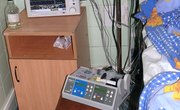Paramedics, the highest level of emergency medical technicians, are life-savers at the scene of a heart attack or auto accident. They provide speedy treatment, stabilize patients and transport them to the hospital. Although the laws vary, every state requires paramedics to complete formal training and become licensed. Most training programs require a high school education for admission and the right preparation during high school provides a solid foundation for your paramedic career.
Essential Classes
A full program of math and sciences classes during high school will help prepare you for technical studies as a paramedic. The Science Buddies website recommends taking geometry and two years of algebra. Knowledge of math prepares paramedics to make calculations and administer medications in the right dose and at the right time. Biology, chemistry and physics are also essential to prepare for classes in anatomy, physiology, pharmacology and pathology during paramedic training.
Recommended Classes
If they're available in high school, classes in anatomy, physiology and biomedical science will help future paramedics prepare for college-level work in these subjects. Because paramedics need excellent communication skills, English and speech classes are important. Science Buddies also recommends foreign language classes, because the ability to communicate with non-English-speaking patients and family members can help paramedics save lives. For example, knowledge of Spanish is invaluable if you live in a state with a high percentage of Spanish-speakers.
CPR Certification
Most EMT and paramedic training programs require CPR certification before you begin training. Cardiopulmonary resuscitation classes teach you how to restore circulation and breathing in ill and injured patients, helping to keep them alive until they get to the hospital. CPR certification classes are available at some high schools and also through the Red Cross at many locations throughout the country.
Driver's Training
Future paramedics should complete the state-required driver's training in high school or at a private driving school and obtain a motor vehicle driver's license. During paramedic training, students are usually required to complete approximately eight hours of additional training for a special ambulance driver's license; a regular driver's license is the first step toward this credential. A clean driving record is also essential to meet the stringent requirements for emergency vehicle drivers.
Other Requirements
Paramedic training programs often have additional entrance requirements, including a background check and immunizations such as tuberculosis, hepatitis B and tetanus, diphtheria and pertussis. In addition to good health, the job of paramedic requires strength and good physical condition. Future paramedics can prepare for the challenges of the job through physical education classes, high school sports or extracurricular activities. Working paramedics need the ability to stand for up to four hours and to help lift patients from the ground to a gurney.
Related Articles
References
- U.S. Bureau of Labor Statistics: What EMTs and Paramedics Do
- U.S. Bureau of Labor Statistics: How to Become an EMT or Paramedic
- Science Buddies: Emergency Medical Technicians & Paramedics -- Key Facts & Information
- California State University, Long Beach: Emergency Medical Technician (EMT) Program
- U.S. Bureau of Labor Statistics: EMTs and Paramedics -- Job Outlook
Resources











